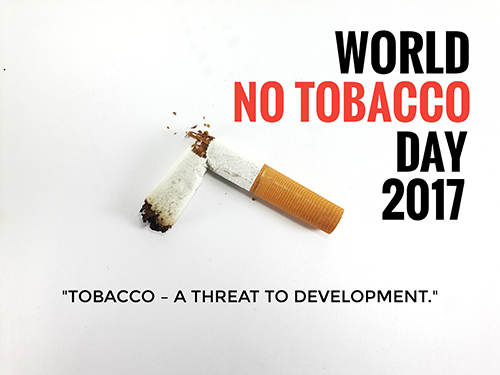
When considering the impact that tobacco has on society, the first thing that comes to mind is the health impacts: cancer, emphysema, heart attacks, strokes and other tobacco-related illnesses. But it’s important to pull back and see what effect this burden of disease and premature death, and the tobacco industry as a whole, has on society. That’s why this year, on World No Tobacco Day, the World Health Organization has chosen to focus on tobacco as a threat to development.
More than 7 million people die each year from tobacco use according to the WHO, and that figure is projected to increase to 8 million by 2030. Roughly 80% of these deaths occur in low- and middle-income countries. This creates an incredible strain on individuals, families, healthcare systems and national economies, increasing healthcare costs and decreasing productivity. Many families are left impoverished when a primary breadwinner dies or is no longer able to work.
Even before a tobacco user is diagnosed with tobacco-related disease, tobacco use is a significant drain on household income. While it varies from country to country, the percentage of median household income it takes to purchase ten cigarettes per day can cost anywhere from 1-3% in countries like Russia and the United States, to as much as 28% in India, or over 36% in Tanzania.
In many countries, tobacco use is more prevalent among people with lower levels of income and education, and the most vulnerable in society. Every dollar spent on tobacco is a dollar that could be spent on food, clothing, healthcare, education or housing – expenditure that actually is beneficial to individual wellbeing and national development.
Instead, this addictive product keeps families in poverty and hunger – perpetuating generational cycles of ill health and poverty – while generating over a trillion dollars in revenue for big tobacco every single year.
And this industry is built on the backs of struggling farmers and their children. In Malawi, for instance, 63% of tobacco-growing families used child labor, and 10-14% of these children have had to stay out of school so that they could work the fields. This arduous, back-breaking work not only deprives these children of an education, it also exposes them to toxic pesticides and the tobacco plant itself, whose leaves leech nicotine onto the skin of harvesters, leading to nausea, vomiting and other symptoms that can indicate green tobacco sickness.
Meanwhile, farmland used to grow tobacco means less land is available for growing beneficial crops, including food crops. The clearing of land for tobacco cultivation and the large amount of wood needed for curing tobacco causes massive deforestation at a rate of approximately 200,000 hectares of land per year on a global basis.
There is no metric in which one can claim that tobacco has benefitted society. The industry will say that it provides jobs for farmers and fills national coffers through the production of a popular product. This is a fabrication. WHO estimates that tobacco costs governments US$ 1.4 trillion through healthcare expenditure and lost productivity.
If the world is committed to achieving the sustainable development goals, we need to increase our commitment to ending the tobacco epidemic. The sole purpose and intent of the tobacco industry is to make as much profit as possible, irrespective of the cost to people’s health and livelihood. In the words of one R.J. Reynolds Tobacco Company executive, “We reserve…[the] right [to smoke] for the poor, the young, the black and the stupid.”
On World No Tobacco Day, we reserve the right to end this epidemic, and help nations and their people to move towards a healthier, sustainable, and more prosperous future.